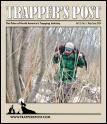

Copyright©2011-25 by Trapper's Post - All Rights Reserved
Website by Hawk Mountain Designs
Article Archives
TRAPPER'S POST
Exclusively Trapping
Next is lure and flagging. We usually place one type of lure in the cubby itself, and a very loud call lure on an object close to the set and 3 to 6 feet off the ground. Flagging can be feathers, wings from game birds, strips of hide, old CDs, or anything that will catch a bobcat's eye. These should be hung near the set with string or monofilament line. We like something fairly flexible, so the flag easily moves in the wind. We really like flagging as it takes advantage of the bobcat's propensity to hunt by sight. Check your state laws to insure it is legal.
The other main component Gary taught me to consistently catch bobcats was location, location, location. Once again, I got a real education and quickly saw where although I had been close in regards to picking locations, I had missed some things.
Bobcats by nature are edge hunters and will often hunt where different habitats come together. This is where rabbits, grouse, small rodents, etc. will be found. Other edges bobcats will often follow are where small streams and creeks border one of the above mentioned habitats. Cats also use frozen waterways as natural travel corridors. We look for any place several of these edges meet. Other locations we target are prominent features found within the habitat or along the edges, like large brush piles, blow downs, trees, or other dominating objects that would cause cats to check for food. After Gary pointed out a few of these I was able to pick them out with ease. One of the best ways to really learn the habits of bobcats is to find a fresh track and follow it. Watch where the cat goes and it will give you an education you won't find in any article or book.
You will quickly find yourself putting on some miles to find these locations, as they are often not found near easy accessible spots. Gary and I have quite a few locations that require driving back in and then walking a distance. We don't have many close to roads. In most cases, some of our best locations are well off the beaten path.

Yes, you can catch cats with pails, but they don't produce consistently as cats often refuse to enter them.

January/February 2011 issue
As a young boy in northern Minnesota I read everything I could get my hands on about trapping. My mother used to tell me to go to bed because I would sit up reading old back issues of Fur-Fish-Game and Trapper and Predator Caller until all hours of the night. One topic that always intrigued me was bobcat trapping. They always seemed to be such a trophy, due to their fickle and reclusive nature. Many of the articles I read were about catching bobcats in the West, or the swamps and forests of the Northeast, which were very similar to ones found around my home. I often told myself that someday I would trap a bobcat.
The years went by and I continued to grow in my abilities as a trapper, catching firsts of many different animals and then catching numbers of mink, coon, rats, and beaver. I did not, however, get an opportunity to catch a bobcat until 1997. My father and I discovered where a beaver trapper discarded carcasses along a small creek. A female bobcat and her young had found these and set up shop in the area. I guarded a baited 5-gallon pail with a #220, lured the set with call lure, and caught the old female on the first night and one of the kittens a week later. As a result I made the fatal mistake of thinking catching cats was easy. The next five years proved me wrong, as I never caught another one. During those years I continued to use #220s and baited pails.


I reside in northern Minnesota, where our bobcat season doesn't open until the end of November. By then there's usually snow on the ground, and footholds are often a hit or miss proposition to keep operating. Bodygrips allowed me to trap without having to worry about the weather putting traps out of commission, and because Minnesota has a 3-day check on bodygrips set on land, I could run a trapline that fit well with my work schedule.
After seeing so many refusals from cats not wanting to work the pails, I finally tried footholds in trails and at natural cubbies I made. I had no success, and was constantly struggling to keep the footholds working in snow and freezing weather. I also now had to check traps daily. Finally in 2002 I managed to catch another bobcat in a baited pail, but by this time I knew if I was going to be consistently successful I needed to find better methods. It took another three years of struggling with no success, before I finally was presented the opportunity to do just that.
In 2005 I had the opportunity to trap for the first time with my good friend and current bobcat trapping partner, Gary Meis. Gary had been successfully trapping cats with #220s for a few years already, and my first year with him revolutionized my mindset on methods. A whole new world of possibilities opened up as he showed me many things I hadn't been doing, or had been doing wrong.
First to go was the plastic pails. Yes, you can catch cats with pails, but they don't produce consistently as cats often refuse to enter them. Also, they were more apt to catch pets because, as Gary explained, many people use these types of pails to feed their pets. Using a more natural dog-proof cubby eliminates this issue.
The system Gary showed me incorporates a wooden cubby made of scrap ½- or ¾-inch plywood, or rough sawn pine boards. Dimensions are: top board, 24 inches long and 11 ¼ wide; bottom, 16 inches long and 11 ¼ inches wide; sides, 18-20 inches long and 10 inches wide. This gives an inside dimensions of 9 ½ inches wide by 10 inches high, allowing use of most brands of #220s. I put it together with 2 ¼-inch wood screws.
Note that the top of the cubby is longer than the bottom, with a 4- to 6-inch overhang, depending on the length of the side boards. This allows room for the cat's legs to step up closer to the cubby. It also makes it more dogproof. We cut 4-inch deep slots in the sides for the trap springs, which results in the trap being recessed 8 to 10 inches back inside the cubby, measuring in from the top overhang. This severely hampers a dog from triggering the trap because they are unable to get their heads far enough in.
The back of the cubby is covered with ½-inch mesh hardware cloth (screen), which allows the cat to look all the way through. Bobcats, I learned, do not necessarily like to enter something they can't see through, or feel they can travel through. The back screen also helps distribute lure and bait odors. A staple gun with 5/8-inch staples holds the screen in place.
Gary's triggering system was not the traditional trigger wires hanging down. He had found cats did not like to push their faces against the trigger wires, and he often got refusals. He developed a pan triggering system that eliminated these refusals. The pan is on the bottom jaws, with the dog on the outer jaw and the pan extending into the cubby. The pans we currently use are made out of hardwood and measure 4 inches wide (side to side) by 1 7/8 inches deep (front to back). Holes are drilled edgewise through the trap pan, and the pan is slid directly on the trigger wires. We bend the pans so they face into the cubby but elevate them to a 45-60 degree angle to keep a bobcat from wanting to reach into the cubby with their paw and forcing them to stick their head in to get the bait. With these pans we not only catch more cats, we also catch furbearers such as weasel and mink, that we would miss using traditional trigger wires. The pan greatly increases the sensitivity of the trigger wires, and it does not take as much pressure to set the traps off.
These pans are easily removed, letting you use the trap for other types of trapping where the trigger wires are needed.
The cubby with the set trap installed is placed on the ground with the front end of the bottom elevated from 4 to 6 inches up off the ground. This does two things. First, it allows the cat to be able to see into the cubby and stick its head in while standing, without having to crouch down. Second, it helps keep snow from building up in front of the cubby. This elevation is easily done by putting a stick under the front end of the cubby.
Bait is put in the back of the cubby. Beaver is best due to its fatty content, which helps keep it from freezing and drying out as quickly as other baits. You can also use deer scraps, rabbit, or other meat. Don't skimp on bait, and make sure to replenish it periodically as shrews and other small critters will eat a lot of it.
Since that first year in 2005, Gary and I have caught 50 bobcats using this set. The Minnesota limit for bobcats is five, with the season running for five weeks, starting in the last week of November going to the first week of January. The set has been a consistent producer throughout the season, although deeper snow periods will make cats hunt harder, and my records show we have somewhat better catch rates then. My records also show that a warming trend following a long cold period has also been good for us.
We have continued to improve upon the system. When we first started we would pre-bait our cubbies but have since stopped and found no drop-off in cats caught. At one time we used both #160s and #220s, but have since gone completely to #220s as we were finding larger 'cats were not always willing to work the smaller cubbies and traps. The #160s will get the job done, but you won't catch the larger toms.
Our traps are swiveled and have cable on them. We now use clips instead of wire to attach traps to anchors, which eliminates carrying heavy wire, a help considering the walking we do.
This system will take bobcats if you take the time to find good locations. If your weather conditions aren't as severe by all means consider footholds with traditional cat sets. If it was feasible for us we would. But our winter conditions call for a different approach, and this one works well for us.


Home | Subscribe | Shop | Books & Videos | Advertise | Past Issues | Photos | Articles | Links | Associations | Testimonials | Guidelines | TP Staff | Contact Us

Trapper's Post
Article Archives



Trapper's Post
Article Archives




Trapper's Post
P.O. Box 128, Scandinavia, WI 54977
Phone: 715-445-2540 Email: office@trapperspost.com

